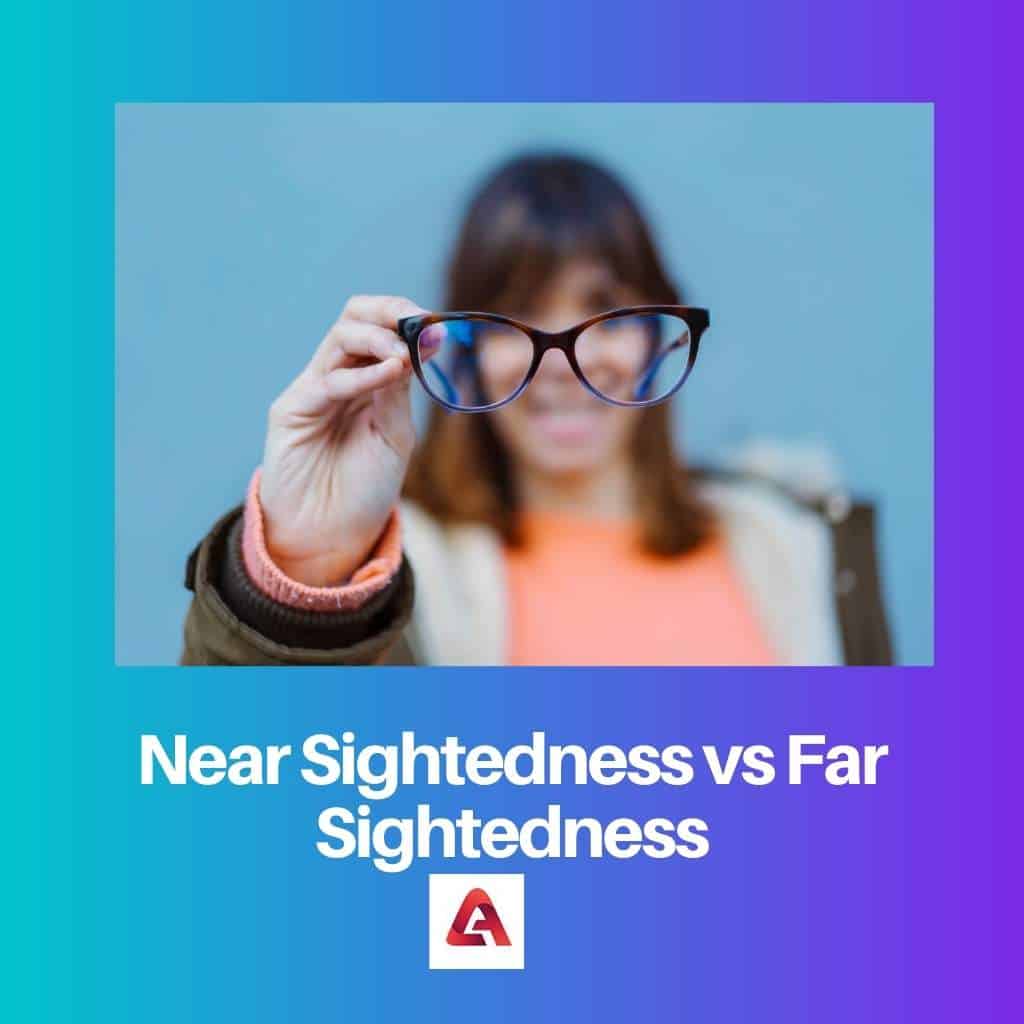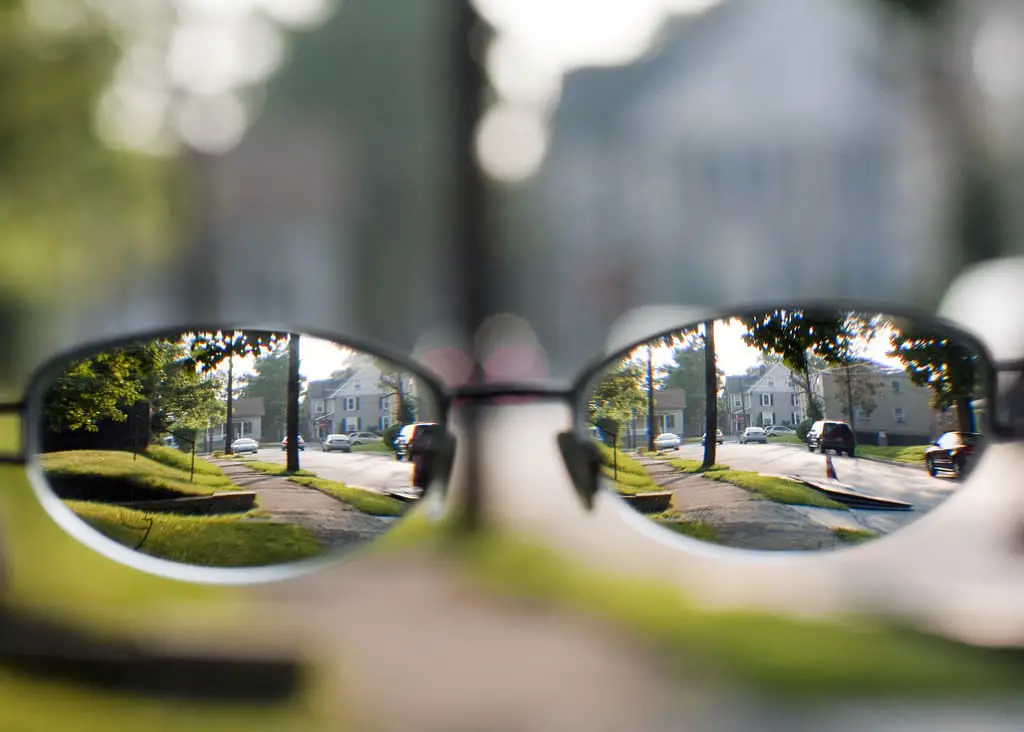One of the most common problems that most of us face in our lives nowadays is the problem of eyesight, or we can call it a refractive error.
In this digital world, where we are now engaged in our mobile phones, laptops, and all sort of screens for different purposes more than ever, this problem has become worse.
Key Takeaways
- Nearsightedness causes difficulty seeing objects at a distance, while farsightedness makes it challenging to focus on close-up objects.
- Nearsightedness results from an elongated or steep cornea, while farsightedness occurs due to a shortened or flat cornea.
- Nearsightedness can be corrected with concave lenses, while farsightedness requires convex lenses.
Near Sightedness vs Far Sightedness
Nearsightedness, or myopia, is when distant objects appear blurry while objects up close appear clear, caused by the eye being too long or the cornea being too curved. Farsightedness, or hyperopia, is when objects up close appear blurry while distant objects appear clear, caused by the eye being too short or the cornea being too flat.

If you are someone who gets troubled checking the time while watching the wall clock kept at a certain distance, even in good lighting, chances are you have Myopia or Near Sightedness.
It affects a significant amount of the Population all over the world and can be corrected with Eye Glasses, Contact lenses, or Surgery.
On the other hand, if you are someone, who faces difficulty in reading books or using a computer, chances are you may have Hypermetropia or Far Sightedness.
It is less common but can become a serious reason for headaches, frequent blinking, etc., if not treated properly.
Comparison Table
| Parameters of Comparison | Near Sightedness | Far Sightedness |
|---|---|---|
| Medical Name | It is also called Myopia. | It is also referred to as Hypermetropia. |
| Position of Objects in focus | One can see Close-up Objects in this. | One can see distant objects in this case. |
| Position of Blurry Objects | Far off Distant Objects looks blurry in this case. | Close-up Objects tend to look fussy in this. |
| Shape of Eyeball | The eyeball grows too long in shape. | Eyeball becomes too small in shape. |
| focus of Light | Light gets focussed, too far in front of the retina. | Here, Light gets focussed, too far past the retina. |
What is Near Sightedness?
Near Sightedness or Myopia is a common eye disorder that makes it difficult to see Distant Objects. It is considered that Myopia is a result of Genetics and Environmental Factors.
It is very common that if your parents have Myopia, you may have it too. It can develop rapidly sometimes and becomes worse in Adolescence.
Its common symptoms include eyestrain, headaches, difficulty in seeing far-off objects, etc. Usually, what happens, is Cornea and Lens present in the eye tend to bend the light coming in so that it can be focused on Retina.
But, in Myopia, our Eyeball becomes long, or the Cornea becomes steep, leading to the focus of light getting Shifted in front of the Retina.
Myopia can also be a result of doing near continuous work or a Lack of outside exposure in childhood. Myopia can be treated with Glasses or Contact lenses. But in Adults, a refractive surgery like LASIK or PRK may be needed in some cases.
Although there is no permanent cure for Near Sightedness, we can improve our overall eye health by Limiting our Screen time, Scheduling Regular eye exams, etc.

What is Far Sightedness?
Far Sightedness, or in medical terms, Hypermetropia or Hyperopia, is another common refractive error that tends to make Close- up objects look blurry.
Sometimes, it gets so bad that people can not focus at all, be it an Object present close to him/her or an Object present at a distance.
It is caused by an eyeball that is too short or an abnormally shaped cornea. These things lead to the light focusing on the back of our Retina instead of its surface.
Most children are born with mild Hypermetropia, which goes away with age. Some people may not notice this condition, especially when young.
Our eyes do 70% of the sensory tasks that our body needs, and a disorder in such a vital sense organ can make your life difficult.
Its symptoms are also similar to Myopia, i.e., Headache, eye strain, or not being able to perceive depth properly. In some cases, it can also be a result of Diabetes or tumours. Generally, it is hereditary, just like Myopia.
It can also be treated with Glasses with positive values, contact lenses, or Surgeries. If not treated properly, with age Far Sightedness can lead to Complications like Strabismus and Amblyopia.
Main differences between Near Sightedness and Far Sightedness
- In Near Sightedness, instead of directly focusing on Retina, light focuses in the front of the Retina, whereas in Farsighted vision, it lightly gets focused past the Retina making close objects look blurry.
- Near-Sighted vision can happen either because of the shape of the eyeball, which can be too long in this case or can also be caused by the shape of the Cornea. In contrast, far-sighted vision is a result of a short eyeball.
- In medical terms, Near Sightedness is also called short-sightedness or Myopia. And Far Sightedness is called Long Sightedness or Hypermetropia (also Hyperopia).
- It is observed that Near-sightedness develops during childhood and worsens during adolescence. But Farsightedness improves as the eyeball lengthens.
- Cases of Myopia are more common in people than that of Hypermetropia.

- https://www.sciencedirect.com/science/article/pii/S0886335001012159
- https://www.sciencedirect.com/science/article/pii/S0886335013804786

It’s interesting to see the reasons behind these common eye conditions. It is a reminder to take care of our eyesight. This is really compelling.
This is a very informative article. It is very useful to learn the difference between Nearsightedness and Farsightedness.
I completely agree with the informative aspect of the article. It’s always good to know the cause and treatment of such common conditions.
The table provides a clear and practical comparison between Nearsightedness and Farsightedness.
The constant use of digital devices have greatly contributed to this problem. It is important to find ways to prevent this problems from getting worse.
The article provides an insightful analysis of the two conditions and it sheds light on the significance of proper eye health.
I appreciate the detailed information on the causes and symptoms of Nearsightedness and Farsightedness. We must be more conscious about our eye health and the effects of modern lifestyles.